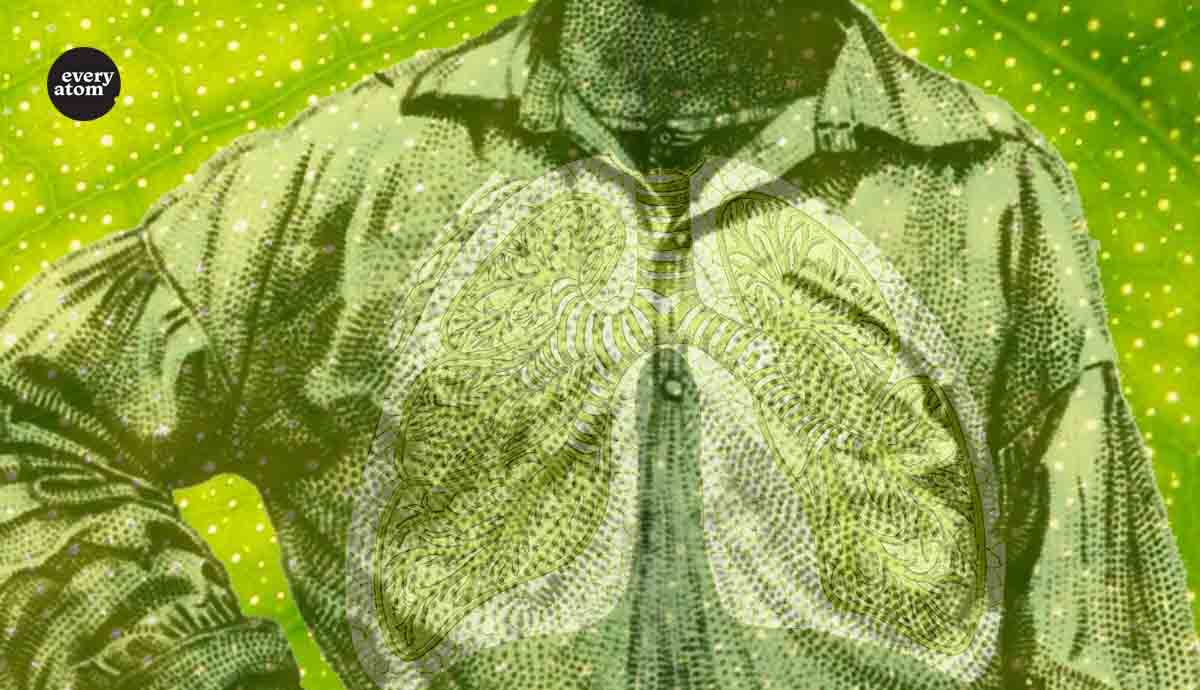Every Atom | No. 79
Introduction to Every Atom by project curator Brian Clements
Every time I read these lines I’m filled with a sense of awe—and gratitude. Awe at Whitman’s pitch-perfect insight into the ways in which respiration and inspiration are, at root, the same process. Awe at how he shows us how they are the same. And gratitude for his teaching me—with such grace and economy—how to recognize that I, too—that each of us—can feel what he felt with every breath we take.
The oxygen he inhales from plants and the air around him passes through him, becoming a part of himself; he then exhales carbon dioxide that is absorbed by the plants around him, which give off oxygen which he then inhales—and the process of respiration begins all over again.
The “sniff of green leaves” and of the shore and the hay— these, too pass through him and become a part of him—setting in motion the inspiration that can be released as “words loosed to the eddies of the wind”—a poem that mysteriously finds its way over time to generations not yet born.
The grass from which the poet takes oxygen is also the grass from which he takes inspiration. It also what connects him with anyone who ever lived—and with us: for we, too, embody the same endless flow of respiration and inspiration.
Whitman promises to give us the “origin of all poems,” and he does just that, whether it is in the lines quoted above, or in the object lesson contained in the passage that begins, “A child said, “What is the grass? Fetching it to me with full hands….”
I guess it must be the flag of my disposition, out of hopeful green stuff woven.
Or I guess it is the handkerchief of the Lord,
A scented gift and remembrancer designedly dropped,
Bearing the owner's name someway in the corners, that we may see and remark, and say Whose?
Or I guess the grass is itself a child . . . . the produced babe of the vegetation.
Or I guess it is a uniform hieroglyphic,
And it means, Sprouting alike in broad zones and narrow zones,
Growing among black folks as among white,
Kanuck, Tuckahoe, Congressman, Cuff, I give them the same, I receive them the same.
And now it seems to me the beautiful uncut hair of graves.
Whitman shows how something as ordinary as grass can inspire his imagination, melding abstract and concrete, alternately the “flag of my disposition, out of hopeful green stuff woven,” and “the beautiful uncut hair of graves” (the latter an image that feels fresh and original despite the fact that he stole it from Homer). We imbibe inspiration, after all, from everything around us, past and present, living and dead—from leaves penned by poets of the past no less than from dry leaves under foot.
Whitman’s insight into the link between “respiration and inspiration” may give him the key to “the origin of all poems;” it is not poetry but creation itself that leaves him breathless and drives him to write lines of such humor and chutzpah that his startled reader can only giggle: “a mouse is miracle enough to stagger sextillions of infidels.”
# # #
Whitman never made it onto the syllabus of any class I took as an undergraduate Honors English major at Yale, where I’d had broad exposure to British literature but almost nothing American. The year after graduation I had a Carnegie Teaching Fellowship at Yale, in which I taught a freshman English course based on a list of assigned texts (nearly all British). During Christmas break, as I prepared for an upcoming unit on Shakespeare, I went to visit a friend in England. One night after dinner while we were washing dishes, I heard the BBC announce that up next would be an actor reading Whitman’s 1855 “Song of Myself.” I had never read it. I had never heard it. What I heard so stunned me that I broke the dish I was washing. Where did that come from, I marveled? And how come nobody ever asked me to read it? It spoke to me as an American. Nothing I’d ever read had done that in quite that way. I decided on the spot that I wanted to be in a field in which “Song of Myself” was required, not “optional.” Back in New Haven, browsing through the course catalogue, I found that there was a field called “American Studies” and that one could get a Ph.D. in it. I applied, was accepted, and have never looked back.
# # #
“Song of Myself” gave me not only the “origin of all poems,” as Whitman promised, but also the game that delighted my children on long car trips and that still intrigues my students at Stanford. I call it “Connections.” It comes from the surprising linkages Whitman makes and models for us—like “my respiration and inspiration.” Or think, for example, of the lines,
The pure contralto sings in the organloft,
The carpenter dresses his plank . . . . the tongue of his foreplane whistles its wild ascending lisp,
Or take,
The pavingman leans on his twohanded rammer—the reporter’s lead flies swiftly over the notebook—the signpainter is lettering with red and gold,
In the game of “Connections,” one player calls out two or three nouns—“contralto and carpenter”—or “pavingman,” “reporter,” “signpainter,” and the next player needs to figure out how they are connected.
Sometimes we’d pick the nouns out of a hat. Or the first three players would each contribute a noun and the fourth would need to connect them. Whitman may make it look easy, but it’s not.
# # #
Awe and gratitude. That’s what I come away with every time I return to “Song of Myself.” Awe at the deft way he manages to persuade us of the oneness of the universe and of our oneness with the universe. And gratitude for his ability to remind us of the complex miracle of being with every breath we take for the rest of our lives.
Recommended
Nor’easter
Post-Op Appointment With My Father
Cedar Valley Youth Poet Laureate | Fall 2024 Workshop







